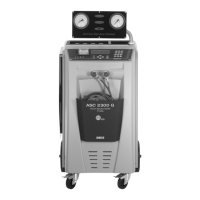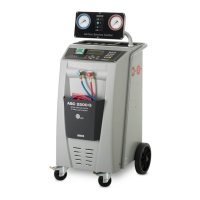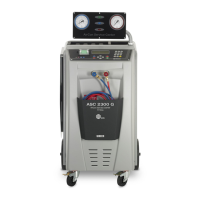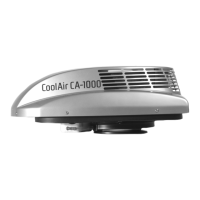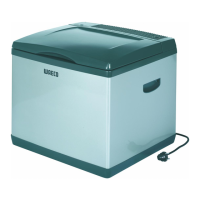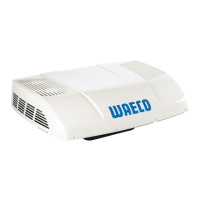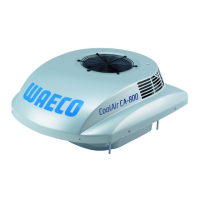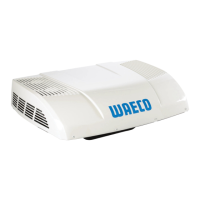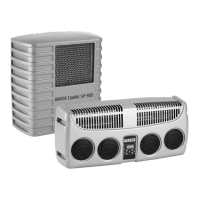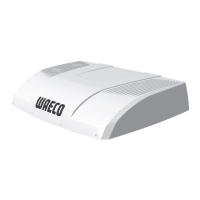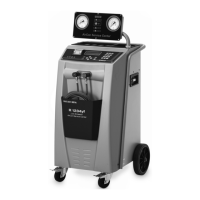
Do you have a question about the Waeco AirCon ServiceCenter and is the answer not in the manual?
| Brand | Waeco |
|---|---|
| Model | AirCon ServiceCenter |
| Category | Air Conditioner |
| Language | English |
Contact information for additional support and inquiries about the service center.
Details symbols used for warnings, cautions, notes, and text formatting in the manual.
Covers national regulations, user qualifications, intended use, and modifications.
Focuses on safe operation, risk of explosion, burns, and slipping hazards.
Guidelines for safe handling of refrigerant, including personal protective equipment and ventilation.
Operator responsibilities for training, instructions, and hose management.
Visual warnings and connection/protection instructions for the device.
Details on built-in safety mechanisms like pressure monitor and fan checks.
Identifies and labels components on the front of the device with diagrams.
Identifies and labels components on the rear and sides of the device with diagrams.
Describes the automated weekly internal pressure and leak test.
Step-by-step guide for physically setting up and powering on the unit.
Explains information displayed on the standby screen, like quantities and dates.
Procedure for changing the display language of the unit.
Procedure for selecting the display font for the unit.
Steps to modify the audible alert volume of the unit.
How to input company details for printing on service logs.
Instructions for setting the unit's date and time for logging.
How to modify preset operational parameters for various service tasks.
Guide to properly install the oil and UV additive containers into the unit.
How to specify the size of the oil and UV additive containers for accurate measurement.
Explains the process and importance of refrigerant purity analysis before draining.
Steps to take if the refrigerant analysis does not pass, including retry options.
Procedure to test the functionality of the refrigerant analysis unit using fresh refrigerant.
Instructions for initial filling of the unit's refrigerant storage from an external source.
Procedures for safely powering down the unit in various critical scenarios.
Overview of the fully automatic air conditioning service process with predefined steps.
Information on protecting unit access with personal user codes.
Steps to set up new user accounts and administrator codes for unit access.
How to log in to the unit using an existing user code after startup.
Guide to creating vehicle-specific data entries for fill capacities and vehicle models.
How to save operational data, like refrigerant consumption, to a USB drive.
How to generate monthly or annual reports manually by transferring data to a USB stick.
How to view and print refrigerant usage overviews, both annual and monthly.
Allows step-by-step execution of individual service processes, omitting optional procedures.
Details on the process of extracting refrigerant and performing pressure tests.
Steps for evacuating the system and performing leak tests for system integrity.
Instructions for refilling oil, UV additive, and refrigerant into the vehicle system.
Guide to choosing the correct hose connections based on the vehicle's AC system configuration.
Steps to take after completing the service, including hose disconnection and valve cap replacement.
Procedure for flushing the system with fresh refrigerant, suitable for oil replacement or residue removal.
How to perform annual leak checks on the unit itself to ensure its integrity.
Procedure to reset and calibrate the scales for accurate oil and UV additive measurement.
Step-by-step guide for replacing the dryer filter, including necessary safety precautions.
Procedures for resetting filter counters and performing leak tests after filter replacement.
Instructions for entering the 12-digit code required for filter replacement.
Guide to calibrating the pressure sensor for accurate pressure readings.
Detailed steps for replacing the oil in the vacuum pump, including safety warnings.
Accessing and understanding various operational meter readings like refrigerant extraction and vacuum time.
Adjusting fill quantities to compensate for different lengths of service hoses.
Procedure for updating the unit's software and database using a USB stick.
Instructions for loading new paper into the unit's integrated printer.
Steps for replacing the receptacle that collects drained oil from the system.
General advice on cleaning the unit's exterior and regularly checking hoses for damage.
Guidelines for the safe disposal of used oils and fluids, noting they are hazardous waste.
Instructions for recycling cardboard and plastic packaging materials.
Procedure for disposing of the entire service unit, requiring draining and qualified handling.
Addresses warnings related to internal vessel status and system pressure during operation.
Covers errors related to insufficient vacuum or detected system leakage.
Addresses warnings for insufficient oil, UV additive, or refrigerant levels.
Covers warnings about filling time, external tank status, and filter replacement prompts.
Addresses pump oil status, printer faults, and specific error codes like 01 and 02.
Details solutions for error codes related to connections, pressure, vacuum, and leaks.
Details solutions for error codes related to pressure drops, hybrid service, and USB recognition.
Details solutions for errors related to unstable readings, calibration failure, and operating conditions.
